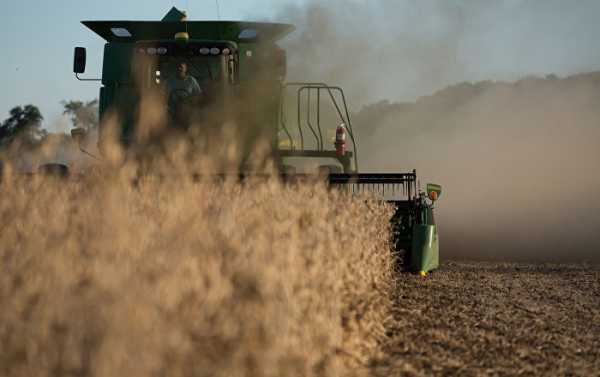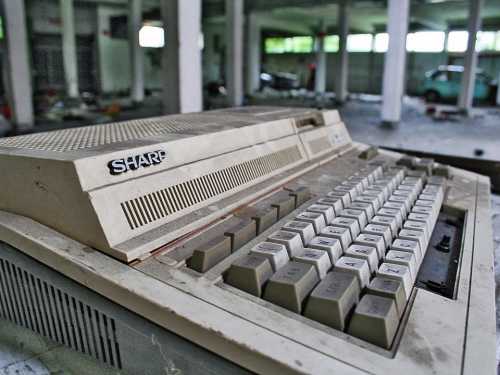
MOSCOW (Sputnik), Tommy Yang – In March, Tim Bardole, a farmer from Rippey, Iowa, borrowed about $500,000 from banks to plant soybeans in the 700 acres of farmland his family manages, and by October, he would have started to sell the harvested soybeans and prepare to pay back the loans.
But after US-China trade tensions drove soybean prices to new lows in recent months, Bardole decided to store the newly harvested soybeans, instead of selling, hoping the prices could bounce back before he has to sell the crop to make loan payments before next March, when he needs new loans to start planting for the new season.
“We’re still in the middle of the harvest. Usually, a lot of the soybeans in Iowa would go to the Mississippi River and down to the Gulf [of Mexico] for export to the Chinese market. That market is not available at this current time. A lot of soybeans are being stored, in hopes that [Chinese] President Xi [Jinping] and [US] President [Donald] Trump can reach an agreement at the G20 Summit and the soybeans can get traded again,” Bardole, who currently serves as the secretary of the Iowa Soybean Association, told Sputnik.
The Iowa-based farmer explained that current soybean prices have made soybeans production unprofitable in the United States.
“The soybean prices are $2 below cost-of-production. Before the China talk [trade tensions] started, we were about $2.3-2.4 above where we are right now, which could put us in a profitable standpoint on soybeans as a producer. It [the low prices] had a huge impact on profitability. It in fact eliminated profitability for soybean production in the United States for this growing season,” he said.
Bardole estimates that his family would lose about $80,000 if they sell the 700 acres of soybeans at the current market prices.
After the Trump administration escalated trade frictions with China by slapping 25 percent tariffs on Chinese goods valued at $50 billion in July, the Chinese government responded with reciprocal tariffs on $50 billion worth of US goods, including key US agricultural exports such as soybeans.
After losing China, the world’s largest soybeans buyer, prices for US soybeans dropped to a 10-year low of $8.55 per bushel in July.
Risk Losing a Lifestyle
Similar to many farmers in Iowa, Bardole comes from a family with a long tradition in farming.
In 1901, his great-great-grandfather bought the family farm, where he still lives and works today. Along with his father, his brother and his son, Bardole’s family manages about 2400 acres of farmland in Iowa.
When his son, who worked somewhere else after graduating from college, decided to return to work on the family farm two years ago, Bardole became really excited because less and less young people in the United States choose to work on a farm today.
“The problem with agriculture in the United States is that there’re not a lot of young farmers. Farming isn’t a job you can just step in and do a month worth of training and be ready to go. It takes years to figure it all out. If the United States loses the young flush of producers, that’ll be a very serious blow to the US agriculture in the next 10-20 years,” he said.
When low soybeans prices made farming unprofitable, Bardole began to worry about whether his son would continue to work on the family farm.
“I’m 51, my brother is 52 and my dad is 75. We can all make it through this and we’ve all been through some tough times before. My real concern is my son, who just started farming. Does he have an eight-month-old baby and a wife that’s kind of grumpy, saying ‘what the heck are you doing farming? We’re not making any money.’ It’s the young guys that have the biggest problem,” he said.
The father said he understands the dilemma his son faces.
“My son grew up with farming. But it just looks different, when you have a baby at home. He’s a very talented young man. He could easily get a job that pays $50,000-100,000 a year. If everything goes to hell, this is what he’ll have to do,” Bardole said.
However, Bardole explained why the farming lifestyle is so important to US farmers like him.
“In the United States, especially the Midwest agricultural states, farming isn’t a job for us. It’s a way of life. It’s something that we really embrace. It’s not something easily given up,” he said.
Oversupply of Soybeans
As US-China trade tensions showed no sign of easing in recent months, the Trump administration tried to work with allies in the European Union to help bring some relief to US soybean farmers, after EU countries started to buy more US soybeans in recent months following a US-EU free trade agreement in July.
According to the latest official figures, soybeans from the United States accounted for about 52.3 percent of total EU imports during the first 12 weeks of the new marketing year 2018-19, up from the 24.8 percent market share of US soybeans in the previous marketing year.
Thanks to strong growth in soybeans exports to EU nations, overall US soybeans exports volume from October 2017 to September 2018 only contracted by 5 percent to 56,717 metric tons, despite exports to China dropping by almost 98 percent in September, the latest figures from the US Department of Agriculture showed.
Bardole explained that the impact of losing the Chinese market would only be felt from November until February when US soybeans start to replace supplies from South America as new harvest arrives.
“Normally, now is when the United States is really moving soybeans. If you look at the past marketing year, our exports were not down very much. But a big reason for that is that our big export period was over by March, when South American production came in. The real impact on trade for US soybeans is from now until January or February, when, historically, a lot of our soybeans are shipped to China,” he said.
However, as China almost bought up soybeans supplies from the rest of the world to meet its massive domestic demand, US soybean producers could enjoy monopoly when dealing with European buyers, industry analysts pointed out.
“When we [EU nations] started to buy more US soybeans, it was because they were cheaper than soybeans from South American countries. But now, they [the US soybean producers] are in a monopoly position, because US soybeans are the only ones available on the market, until February to March. We expect the price [for US soybeans] to go up,” Laurent Crastre, oilseed analyst at Strategie Grains, a France-based business consulting firm, told Sputnik.
The analyst expects prices for US soybeans to rebound to around $9 without further hikes, as US soybeans remain in a status of oversupply thanks to successful harvest in the past two years.
“The stocks of soybeans in the United States are really huge. There was a huge surplus as the end of the marketing year, because of the big harvest they experienced in both 2017 and 2018. Normally, if you look at the correlation between US soybeans stock and prices, the prices would be much lower than they are now,” he said.
According to the latest projections from the US Department of Agriculture, US soybean production in 2018 is expected to reach a record of 4.6 billion bushels, up 4 percent from the previous record high of 4.43 billion bushels of last year.
Crastre, the industry analyst, estimates the oversupply of US soybeans is likely to lead to low prices until 2020, as US soybeans exporters are still shipping harvest from last year.
US soybean prices skyrocketed to an all-time high of almost $18 per bushel in September 2012, after the worst drought in the United States in 56 years severely devastated the drop.
Support Trump’s Trade Policies
Although the Trump administration’s hostile trade policies against China triggered Chinese responses that plunged US soybean prices, Bardole, the farmer from Iowa, believes it was the right thing to do, in spite of the financial difficulties his family faces.
“There’re definitely trade problems with the way China historically deals with things. Some of the things they do are really unfair for trade. It’s not just in agriculture. If you look at technology or industry, there’re other issues where China needs to change the way they do business to better follow the rules of the WTO [World Trade Organization]. The issues at hand are a lot bigger than me and my operation. I think what President Trump is trying to do is good for the country,” he said.
Bardole gave an example that Chinese buyers used to try to manipulate US soybean prices by canceling orders right before shipment and then confirmed the orders again after the prices dropped.
The US farmer added that the trade issues with China should have been dealt with 15 years ago, but there has not been a US president willing to stand up and start negotiations to get things fixed.
“I definitely support what president Trump is trying to do. And I hope he can get a fair settlement that is not only fair for me, my family and our country, but also good for China. As a soybean producer, we have a lot of good customers in China. We want them to be successful. And we want China as a country to be successful. If they can function within the world economy strongly, it’s good for the world,” he said.
Bardole voted for Trump during the 2016 US presidential election and voted for the Republican Party during this month’s US midterm elections. He plans to vote for Trump again in the upcoming 2020 US presidential election.
As for Bardole’s personal financial struggles amid low soybean prices, the Trump administration has initiated an aid program, known as Market Facilitation Payments, which offers US soybean farmers $1.65 per bushel to compensate for their losses.
But Bardole said the aid program is unlikely to help him break even for this harvest season.
“Maybe I’ll bake our banker a pie and make him like us more? In the United States, you can buy crop insurances. We bought crop insurances last winter. So I think we’ll be able to stay current on our loan payments. Hopefully, the banks will allow us to borrow for next year’s production,” he said.
The US farmer plans to adjust the number of soybeans he plants for next growing season, although he did acknowledge that the other crop he can grow is corn, which already occupies about 65 percent of his farmland.
Sourse: sputniknews.com






